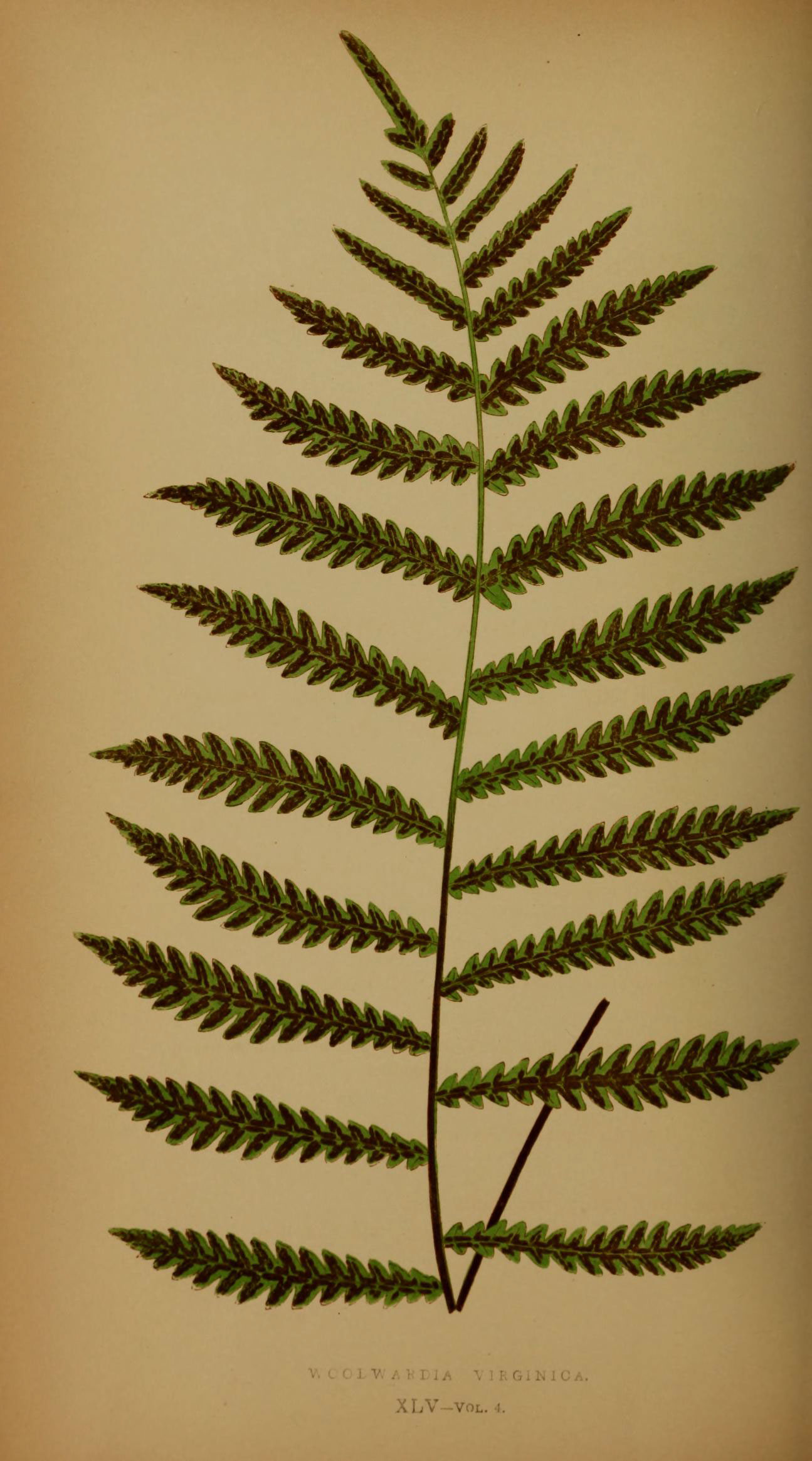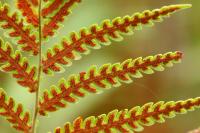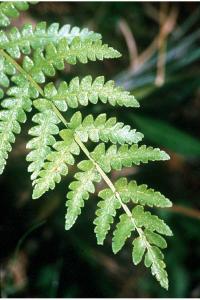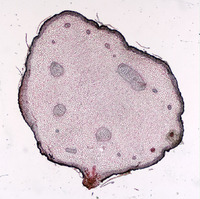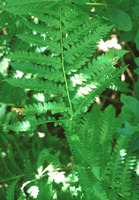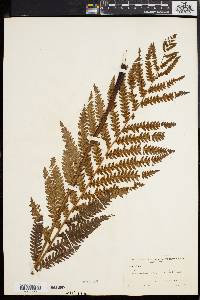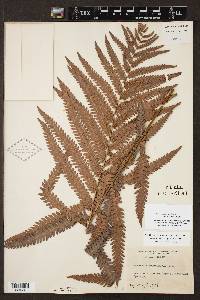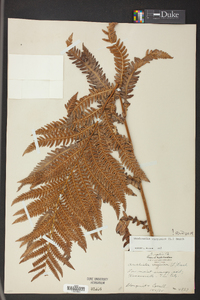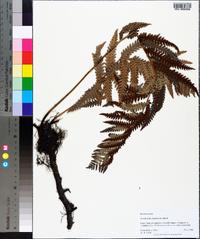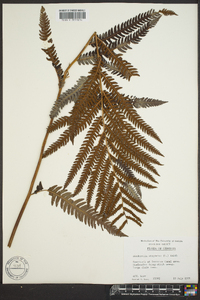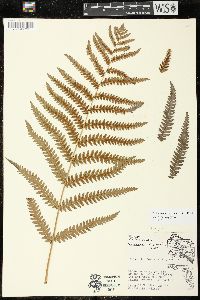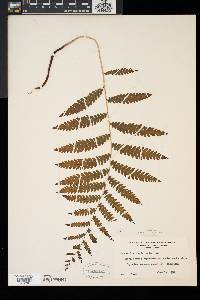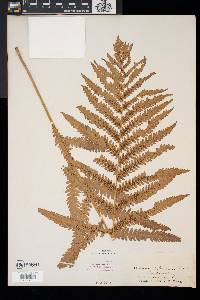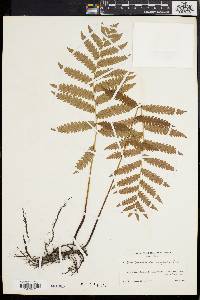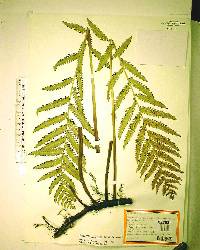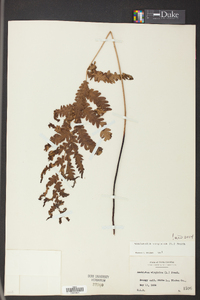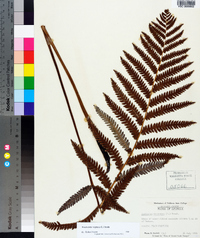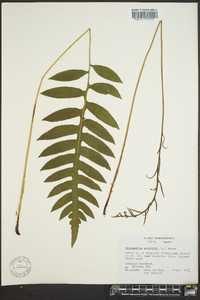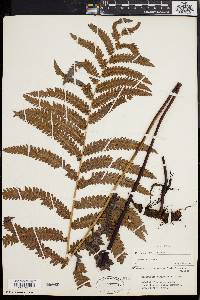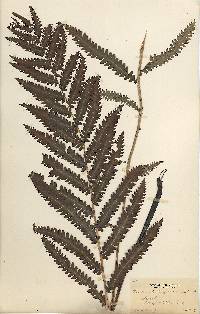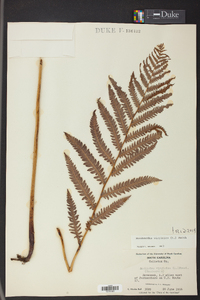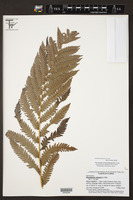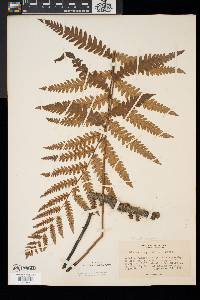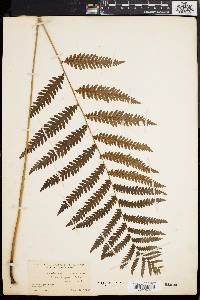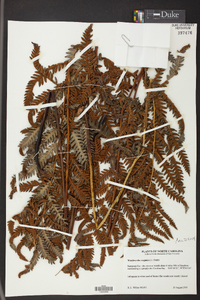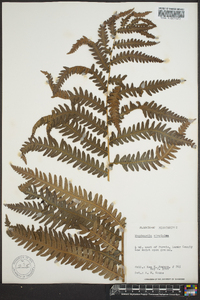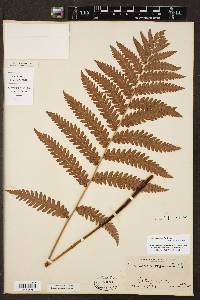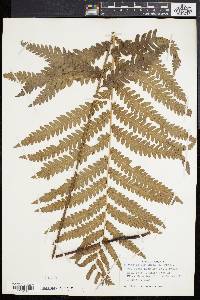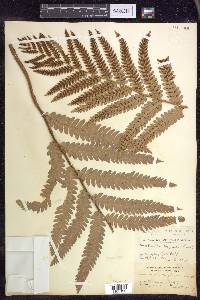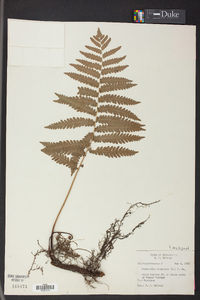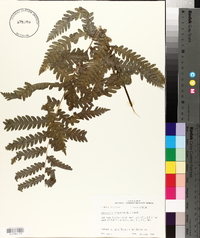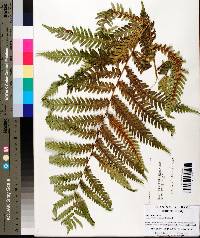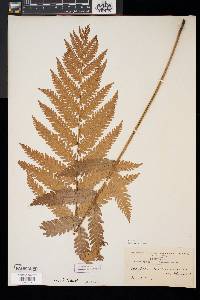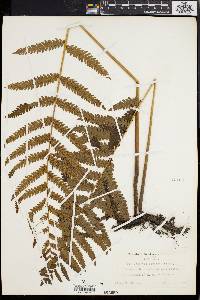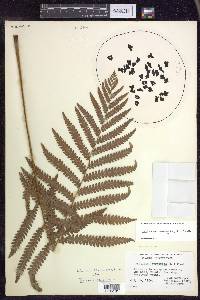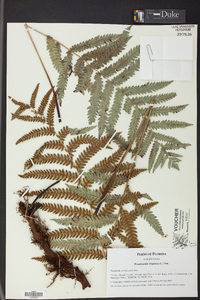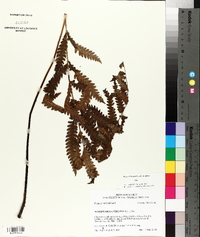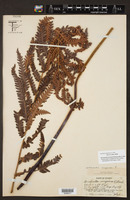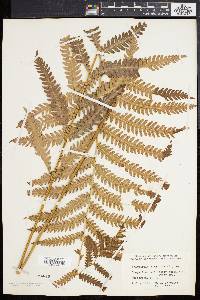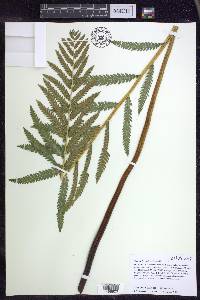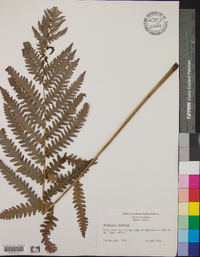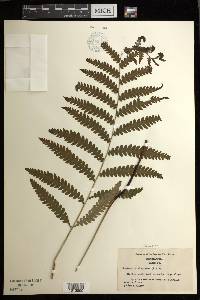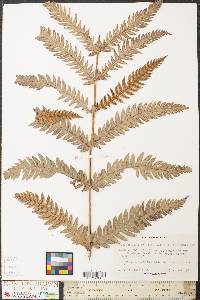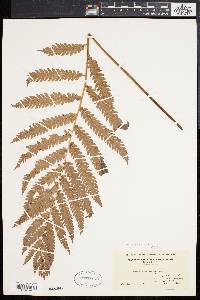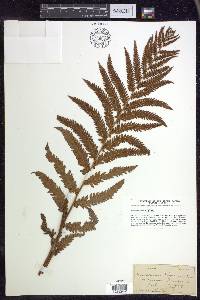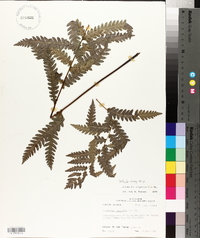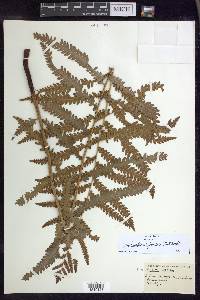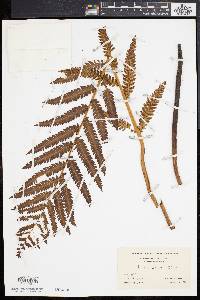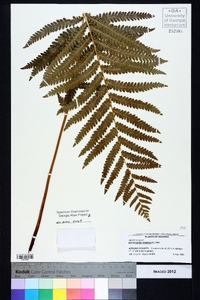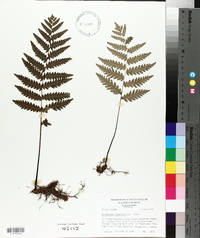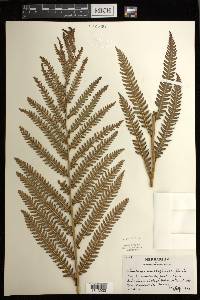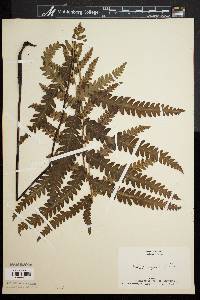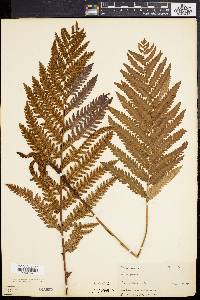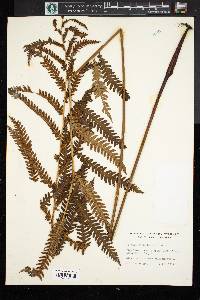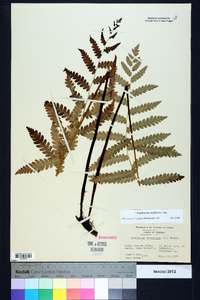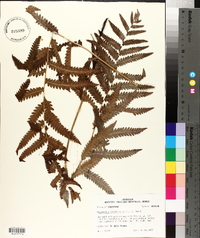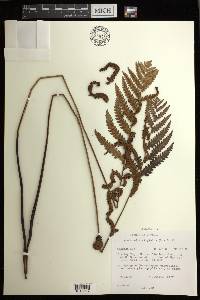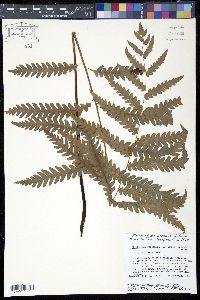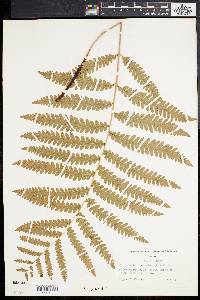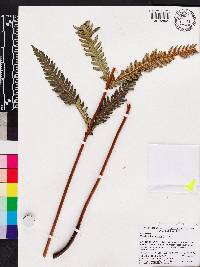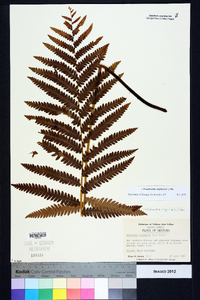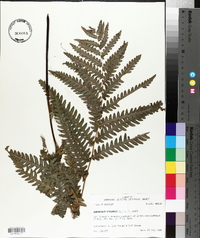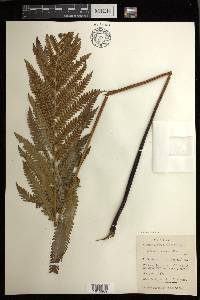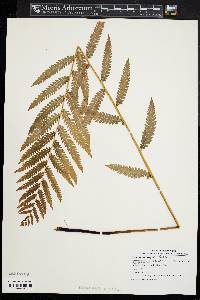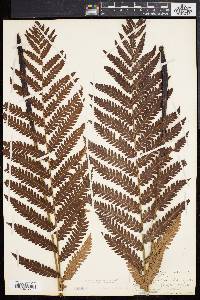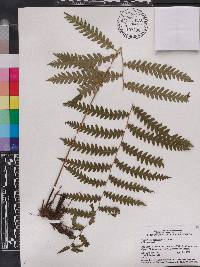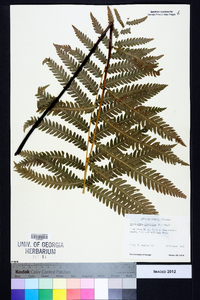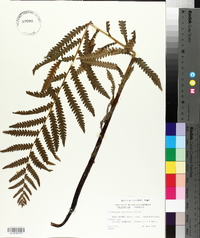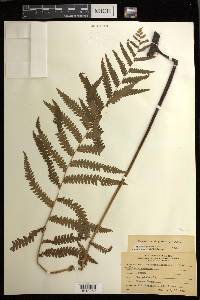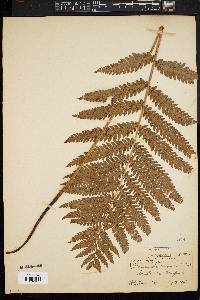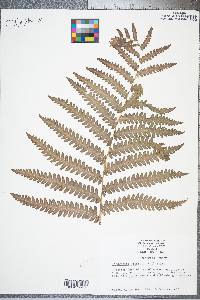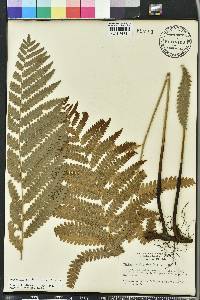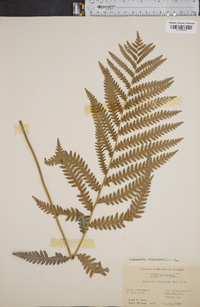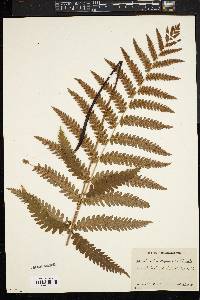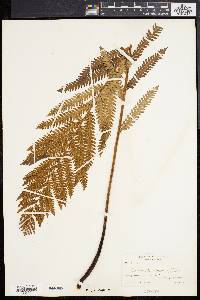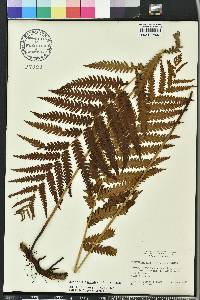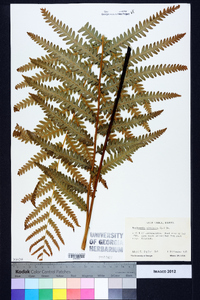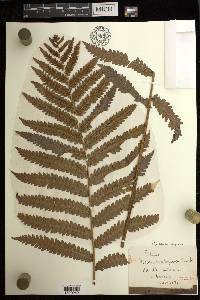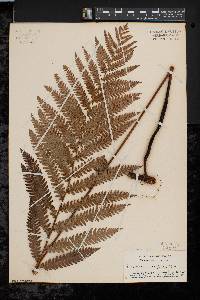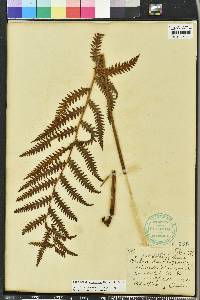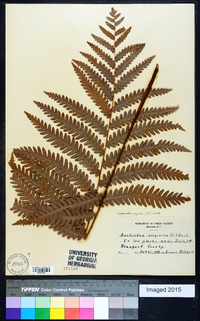
|
|
|
|
Family: Blechnaceae
Virginia chain fern, more...Virginia Chain Fern
[Blechnum virginicum L., moreDoodia virginica (L.) C. Presl, Woodwardia bannisteriana Michx., Woodwardia virginica (L.) Sm.] |
Stems long-creeping, ropelike; scales dark brown, few, triangular. Leaves monomorphic, deciduous, numerous, well separated, 50-100 cm. Petiole dark purple to black proximally, straw-colored distally, base lustrous and swollen, glabrate. Blade greenish, lanceolate, 28-60 cm, bearing mixture of glands and scales upon emergence with glands persisting. Pinnae articulate to rachis, arranged in 12-23 evenly distributed pairs, linear to narrowly lanceolate, deeply pinnatifid; middle pinnae 6-16 × 1-3.5 cm. Veins anastomosing to form a single row of areoles, then free to margin. Sori elongate, linear, superficial, often appearing confluent upon dehiscence of sporangia. Indusia ± membranous, lacking thickened cells, freely spreading, often hidden by dehisced sporangia. 2 n = 70. Swamps, marshes, bogs, and roadside ditches over noncalcareous substrates; 0-300 m; N.B., N.S., Ont., P.E.I., Que.; Ala., Ark., Conn., Del., Fla., Ga., Ill., Ind., La., Maine, Md., Mass., Mich., Miss., N.H., N.J., N.Y., N.C., Ohio, Pa., R.I., S.C., Tenn., Tex., Vt., Va., W.Va.; Bermuda. Woodwardia virginica is primarily confined to the coastal plain of eastern North America. It is not likely to be confused with any other species of the genus, but it is sometimes mistaken for Thelypteris palustris (Linnaeus) Schott, T . interrupta (Willdenow) K. Iwatsuki, or Osmunda cinnamomea . It may be distinguished from the first by having netted venation, from the second by having linear sori, and from Osmunda by having blackish petiole bases.
Perennial fern 0.5 - 1 m tall Leaves: numerous, erect, greenish (often somewhat reddish when young), deciduous, glandular (also scaly at first emergence), 28 - 60 cm long, up to 25 cm wide, lance-shaped in outline, but pinnately divided with the divisions (pinnae) further pinnately lobed. Rhizome: long-creeping, 0.6 - 1 cm thick, rope-like, and covered with a few dark brown, triangular scales. Leaf stalks: well-separated along rhizome, erect, swollen at base, lustrous and dark purple to black near base, straw-colored upward, mostly hairless. Spores: all of one kind, single-sectioned (monolete), and kidney-shaped. The spores are released in June and July, and give rise to the gametophyte (the sexual phase of the plant), which is small, green, heart-shaped, sometimes hairy (with hairs like stalked balls), and sits above the ground. Similar species: Woodwardia virginica is somewhat similar to the very rare W. areolata, but that species can be distinguished by having sunken sori and two extremely different shaped fertile and sterile leaves (dimorphic), which are only pinnately divided or lobed one time, and have the veins join together in a netlike pattern to form discreet enclosures (areolae) in at least two rows (usually for most of blade surface) with the veins separating only at the blade edges. Sometimes W. viriginica is confused with Thelypteris palustris var. pubescens, but that fern has rounded sori and lacks netlike vein patterns. It may be possible to confuse this species with Osmunda cinnamomea, but that species does not have blackish bases on the leaf stalks, and the fertile fronds are very different from the sterile fronds, appearing similar to cinnamon sticks. Another possible similarity is with Deparia acrostichoides, but that species does not form netlike vein patterns, and has the sori arranged along the veins of the leaf segments so they are at an angle to the segment midrib with the indusia opening at an angle to that midrib. Some may also confuse W. virginica with Athyrium filix-femina var. angustum, but that fern often has fully twice compound leaves, the sori are arranged at an angle to the final segment midrib, the sporangial stalks have glandular hairs, and the obvious indusia are toothed. Superficially, some small plants of Matteuccia struthiopteris var. pensylvanica may have a slight resemblance, but the sori of that species are rounded and near the leaf segment edges, which roll back toward the sori. Habitat and ecology: Not common, but can be frequent in particular habitats, especially bogs in the eastern half of the Chicago Region. Occurence in the Chicago region: native Notes: There are only three species of Woodwardia in North America. This species, like W. areolata, is somewhat confined to the coastal plain of eastern North America, but is also disjunct in the Chicago Region. The Blechnaceae family can be separated from other fern families based on the netlike vein patterns that form series of discreet enclosures (areolae), elongate sori with indusia that open toward the midvein, bilateral spores, and chromosome base numbers mostly between 28 and 36 (Cranfill 1993). Author: The Field Museum Rhizome 6-10 mm thick; lvs monomorphic, to 14 dm, the petiole purplish-brown, shining, the blade lance-oblong, to 5 נ2.5 dm, acuminate, pinnate- pinnatifid, the pinnae 15-20 pairs, pinnatifid with a rachis 1-1.5 mm wide, the segments 15-20 pairs, ovate to broadly oblong, with cartilaginous margins; veins forming a single series of areoles along the costa and costules, otherwise free, indusia thin, soon recurved, those along the costules only 1-1.5 mm, those along the costae larger; 2n=70. Swamps and moist places in acid soil; N.S. to Fla., w. to Ont., Mich., Ill., and Tex.; Bermuda. (Anchistea v.) Gleason, Henry A. & Cronquist, Arthur J. 1991. Manual of vascular plants of northeastern United States and adjacent Canada. lxxv + 910 pp. ©The New York Botanical Garden. All rights reserved. Used by permission. From Flora of Indiana (1940) by Charles C. Deam This fern is infrequent to very local in the area shown on the map. Usually where it is found it is common. It grows in bogs and marshes. Its preferred habitat is old tamarack bogs and its most common associate is Chamaedaphne. The sterile fronds of this species resemble those of Osmunda, Dryopteris, and Athyrium, but the fronds of Woodwardia may be distinguished by the areolae in the venation along the midrib. …… Indiana Coefficient of Conservatism: C = 10 Wetland Indicator Status: OBL |
|
|
|

